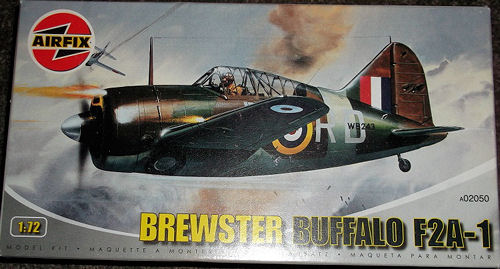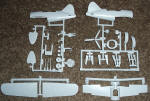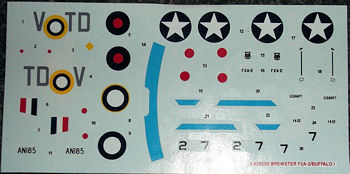Airfix
1:72 Brewster Buffalo F2A-1
|
KIT #: |
02050 |
|
PRICE: |
NZ$17.99 |
|
DECALS: |
Two options |
|
REVIEWER: |
Zac
Yates |
|
NOTES: |
Re-issue |

“The Brewster F2A (named
Buffalo
by the RAF) was designed in 1936 to replace the large numbers of US Navy biplane
fighters, which were rapidly being outclassed, and became the first monoplane
fighter to enter service with the USN. The prototype B-139 XF2A-1 first flew in
December 1937, and had a disappointing performance. Several modifications to the
airframe, engine and armament brought the design up to acceptable standards, and
a production order for 54 B-239/F2A-1s was placed, the type entering service
with VF-3 on
8 December 1939.
Only 11 machines were delivered, the remainder being diverted to
Finland.
“By this time the
improved B-239/F2A-2 was in production, with 43 going to the USN. Belgium
ordered 40 B-339Bs, the UK 170 B-339Es and the Netherlands East Indies 72
B-339Ds, followed by a further 20 B-439/F2A-3s, all of these export models
having arrestor gear and catapult pools removed. The USN also ordered 108 F2A-3s
in 1941, most of these being relegated to the training role, and by the end of
1941 development work and production had ceased.
“After the start of
World War Two, US Marine Corps Squadron VMF-221 was the only American unit to
use the type in combat when, on 4 June 1942, their 19 F2A-3s fought at the
Battle of Midway with a loss of 13 aircraft to the Japanese fighters.
Several Belgian aircraft were diverted to the
UK,
while the British orders were diverted to the
Far
East
theatre for the defence of
India,
Malaysia
and
Singapore.
The Royal Australian Air Force and Royal
New
Zealand
Air Force also supplied squadrons to fly these Buffalos alongside the RAF, and
although they put up a valiant defence were completely outclassed by the
Japanese fighters. The RAAF also operated three squadrons of Buffalos in
Australia.”
(from the kit instructions)
Reading the accounts
of pilots who flew the
Buffalo
in combat in the
Far East
it becomes apparent that they had no love for the machine as a fighter: it was a
tool that was generally no good for the job. Some pilots had the original .5
Colt machineguns replaced with .303 Brownings as the former were troublesome and
sometimes would fire only four rounds before jamming. The aircraft was
delightful to fly but struggled to gain height, so the British and Commonwealth
pilots often found themselves on the defensive in combat. However, despite the
aircraft’s shortcomings many victories were scored against the attacking
Japanese forces before the aircraft were replaced by more capable modern types.
While the RAF had
limited success and the USN next to none, the Finns achieved great things with
their Buffaloes: at one time the kill ratio of their crews was 32 enemy aircraft
downed for every one of their Brewsters. Such was the skill of the Finnish
pilots that 36 of them made “ace” on the type (one, Hans Wind, scored 39 kills
in Buffaloes). In comparison to the Commonwealth pilots the Finns found the
aircraft to have few maintenance issues, was easy to fly and took comfort in its
long range. Replaced by the Bf109G in WW2, the last Finnish Air Force
Buffalo
flights were in September 1948.
Only one
Buffalo
remains today: Lieutenant Lauri Pekuri’s BW-372 was raised from a Russian lake
in 1998 and is now on display in as-recovered condition at the Keski-Suomen
Ilmailumuseo (Aviation
Museum
of Central
Finland).
This museum also has parts of F2A-1 BW-393 on display. Two static replicas also
exist, built by the Cradle Of Aviation Museum in Long Island, NY: one of these
is on display at that museum as an F2A-2, the other (a B-339C) at the Militaire
Luchtvaart Museum at Soesterberg in the Netherlands.
 This
is truly 1960s-era Airfix: nice accurate lines, very little interior detail
(seat, floor and a nicely detailed pilot), not many parts, and rivets and
ejector pin towers everywhere. As soon as you open the box you see four small
sprues of light grey (and somewhat flashy) plastic, and one of thick clear. The
only engraved exterior detail is the control surface demarcation lines; every
other panel line is raised.
This
is truly 1960s-era Airfix: nice accurate lines, very little interior detail
(seat, floor and a nicely detailed pilot), not many parts, and rivets and
ejector pin towers everywhere. As soon as you open the box you see four small
sprues of light grey (and somewhat flashy) plastic, and one of thick clear. The
only engraved exterior detail is the control surface demarcation lines; every
other panel line is raised.
There are two sets of
undercarriage legs and doors in the box, but only one set is mentioned in the
instructions. I’m guessing that the other parts would have been used to
represent retracted gear on an “in-flight” model as in many vintage Airfix kits.
If this is to be done one must figure out the parts placement on their own and
find a suitable stand. There is no wheel well detail at all.
The
Buffalo
was armed with four machineguns. The muzzle ports for the guns in the engine
cowling are there, but the wings have no openings for theirs so they must be
located and drilled. The wing folds are moulded as very deep trenches, but I
have the feeling these need to be filled for the RAAF aircraft as no pictures
I’ve seen of these aircraft show them.
As one of the two
decal options is a naval aircraft there is a tailhook included. In common with
many kits of the era the fuselage has a slot so this can extend and retract, and
the instructions mention that it should not be cemented in place. The naval
variant also has a different tailwheel with a canvas boot, the life-raft
container for behind the pilot, and the telescope-style gunsight. The landplane
tailwheel is also included for the other option (but the turnover truss is not).
Surprisingly the Wright Cyclone radial engine is very nicely detailed with
petite cooling gills.
There are four, flashy
clear pieces. The unusual ventral window is included, as are two different
windscreens (one with a slot for the gunsight), and the expansive rear glazing.
The sliding canopy is moulded separate, but I’m not sure if it would fit
 over the
rear section (Squadron make a vacform replacement that is readily available).
over the
rear section (Squadron make a vacform replacement that is readily available).
As mentioned above,
there are two decal options: one is an F2A-2 of VF-2 US Navy aboard the USS
Lexington in 1941, the other is TD-V/AN185 of 453 Squadron, RAAF, flown in
action by Flight Lieutenant RD “Van” Vanderfield. This aircraft and pilot
combination shot down three Japanese aircraft on
December 13 1941,
an action made even more surprising by the fact that the
Buffalo’s
landing gear was so extensively damaged it remained extended for the whole
flight. Strangely, the aircraft featured in the striking box art is not one of
the options, and possibly not even one that served: the serial W8243 doesn’t
appear in the seminal Buffaloes Over
Singapore, but the RD squadron codes
were used by a
Buffalo
squadron (67 Sqn RAF).
For an aircraft that seemed so obsolescent,
unloved in the West and incapable of holding its own against modern opponents,
the
Buffalo
has been well represented in kit form. This was probably the first, followed by
another effort by Matchbox in the 1970s.
(Editor's Note: Revell also did a Buffalo that is about the same age as the
Airfix kit as it was at one time part of their aircraft three-packs.)
These have both now been surpassed by the expensive but apparently much more
accurate and detailed kit from Hasegawa (do not
forget the Special Hobby/MPM kits in this scale. Ed),
as well as Tamiya and Special Hobby (and Classic
Airframes) offerings in
1:48.
The Airfix kit though is great for the beginner or to cure a bout of
AMS
as it’s sure to go together very well and will certainly look like a
Buffalo
when complete.
Buffaloes
Over
Singapore:
RAF, RAAF, RNZAF and Dutch Brewster fighters in action over
Malaya
and the East Indies 1941-42
– Brian Cull with Paul Sortehaug and Mark Haselden
www.airforcemuseum.fi/brewster_arrived_finland
www.en.wikipedia.org/wiki/Brewster_Buffalo
www.m.flickr.com/#/photos/23269353@N00/4131274045/in/photostream
www.militaireluchtvaartmuseum.nl/
http://rodb.gofreeserve.com./Av09/Cradle%20of%20Aviation%20Museum/Brewster%20Buffalo%20replica.html
Zac Yates
April 2012
If you would like your product reviewed fairly and fairly quickly, please contact the editor or see other details in the
Note to
Contributors.
Back to the Main Page
Back to the Previews Index Page
This
is truly 1960s-era Airfix: nice accurate lines, very little interior detail
(seat, floor and a nicely detailed pilot), not many parts, and rivets and
ejector pin towers everywhere. As soon as you open the box you see four small
sprues of light grey (and somewhat flashy) plastic, and one of thick clear. The
only engraved exterior detail is the control surface demarcation lines; every
other panel line is raised.
over the
rear section (Squadron make a vacform replacement that is readily available).